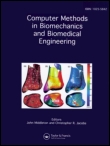Remodelling of trabecular bone is essentially affected by the mechanical load of the trabeculae. Mathematical modelling and simulation of the remodelling process have to include time-consuming calculations of the displacement field within the complex trabecular structure under loading. We present an adaptive diffuse domain approach for calculating the elastic bone deformation based on micro computer tomogram data of real trabecular bone structures and compared it with a conventional voxel-based finite element method. In addition to allowing for higher computational efficiency, the adaptive approach is characterised by a very smooth representation of the bone surface, which suggests that this approach would be suitabe as a basis for future simulations of bone resorption and formation processes within the trabecular structure.

Remodelling of trabecular bone is essentially affected by the mechanical load of the trabeculae. Mathematical modelling and simulation of the remodelling process have to include time-consuming calculations of the displacement field within the complex trabecular structure under loading. We present an adaptive diffuse domain approach for calculating the elastic bone deformation based on micro computer tomogram data of real trabecular bone structures and compared it with a conventional voxel-based finite element method. In addition to allowing for higher computational efficiency, the adaptive approach is characterised by a very smooth representation of the bone surface, which suggests that this approach would be suitabe as a basis for future simulations of bone resorption and formation processes within the trabecular structure.
